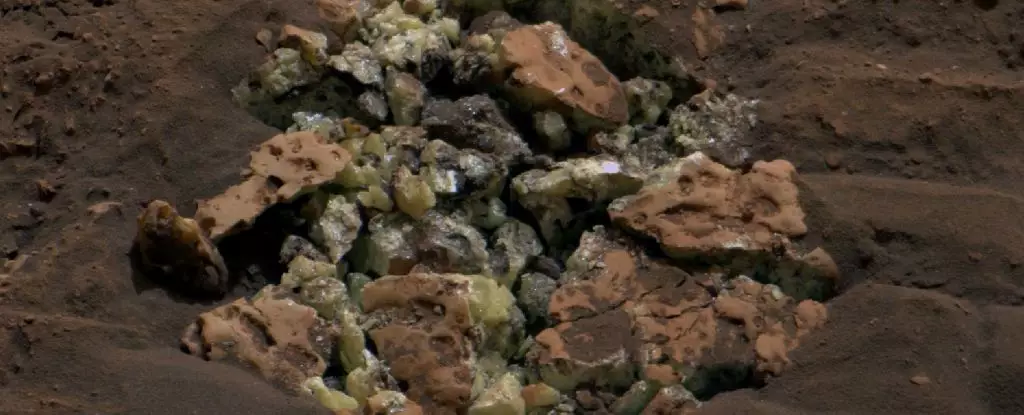In a remarkable turn of events, NASA’s Curiosity rover uncovered pure elemental sulfur on Mars, marking a significant milestone in our understanding of the planet’s geology. During its exploration of the Gediz Vallis Channel, the rover’s substantial mass caused an unassuming rock to crack open, revealing a stunning interior filled with bright yellow crystals of sulfur, often referred to as brimstone. This accidental discovery ignites intrigue, as it is the first documented instance of sulfur found on Mars in its uncombined state, contrasting with the common sulfates that have been identified in various locations on the Martian surface.
With sulfates being salts formed from the interaction of sulfur and other minerals in the presence of water, their presence hints at complex historical climates that might have existed on Mars. Yet, the emergence of elemental sulfur suggests that certain conditions that favor its formation might have occurred, which were not previously anticipated. This fortuitous event has created ripples of excitement within the scientific community, leading experts to hypothesize about the implications of such a find.
The Gediz Vallis Channel is particularly interesting due to its geological history, marked by ancient water flow that sculpted the landscape over billions of years. The presence of numerous rocks resembling the sulfur-rich specimen before Curiosity altered it raises questions about the potential abundance of elemental sulfur in this region. Ashwin Vasavada, the project scientist for Curiosity, likened this discovery to finding an oasis in an otherwise barren desert—a phenomenon that defies geological expectations and invites further investigation.
Understanding the formation of pure sulfur, which requires specific environmental conditions, remains a challenge for scientists. Unlike sulfates, which can easily form under a variety of conditions, the emergence of pure elemental sulfur poses new questions about the Martian environment and its evolution. Such a find implies that there may be undiscovered geological processes or historical events that have yet to be understood, leading to critical inquiries into Mars’s past climatic conditions.
One of the most compelling aspects of sulfur is its essential role in the biological processes of life as we know it. Typically, organisms absorb sulfur in the form of sulfates, which are utilized in synthesizing key amino acids necessary for protein formation. Although the current find primarily enhances our understanding of Martian geology rather than revealing clear signs of life, it deepens our insight into Mars’s potential habitability in ancient times.
Curiosity’s mission is not merely to identify compounds but to piece together the story of Mars as a once-hospitable world. The presence of resources critical for life, such as water and various necessary chemical elements, hints at a more complex history than previously understood. Each discovery contributes a layer to our understanding of what made Mars suitable for life billions of years ago.
The Path Forward: Investigating Mars’ Geological History
Looking ahead, the immediate task for Curiosity and its team is to develop a comprehensive understanding of how elemental sulfur came to exist in the Gediz Vallis Channel. This will entail detailed modeling of the geologic history of Mars, examining how the interplay of various forces and factors could allow for such occurrences.
As Curiosity continues its journey through the ancient Martian landscape, it remains poised to gather further data and insights that may unlock the mysteries surrounding this newfound treasure. With each move, there exists the tantalizing potential of further surprises hidden amongst the rocks of this distant world, serving as a reminder of the enduring allure of planetary exploration.
The accidental revelation of elemental sulfur on Mars encapsulates the essence of scientific exploration—curiosity leading to unexpected discoveries. The implications of this finding extend far beyond mere geological interest; they encourage us to imagine a time when life may have flourished in an environment now viewed as stark and desolate. As we continue to unravel the secrets of Mars, we draw closer to understanding our neighboring planet’s history and its role in our solar system.

